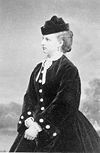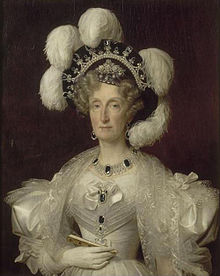- Maria Amalia of Naples and Sicily
-
Not to be confused with Princess Maria Amalia of Bourbon-Two Sicilies (1818–1857).
Maria Amalia of Naples and Sicily Queen consort of the French Consort 9 August 1830 – 24 February 1848 Spouse Louis Philippe I Issue Ferdinand Philippe, Duke of Orléans
Louise, Queen of the Belgians
Marie, Duchess Alexander of Württemberg
Louis, Duke of Nemours
Clémentine, Princess of Kohary
François, Prince of Joinville
Charles, Duke of Penthièvre
Henri, Duke of Aumale
Antoine, Duke of MontpensierHouse House of Orléans
House of the Two SiciliesFather Ferdinand I of the Two Sicilies Mother Maria Carolina of Austria Burial Chapelle royale de Dreux, Dreux, France Religion Roman Catholic Maria Amalia of Naples and Sicily, sometimes known as Maria Amalia of the Two Sicilies (Maria Amalia Teresa; 26 April 1782 – 24 March 1866) was a Princess of Naples and Sicily[1] and later the Queen of the French from 1830–1848, consort to Louis Philippe I.
Contents
Biography
Early years
Princess Maria Amalia was born on 26 April 1782 at the Caserta Palace outside Naples, Italy. Her parents were the King of Naples and Sicily, Ferdinand IV, and his wife, the Austrian daughter of Empress Maria Theresa, Maria Carolina.
Her mother’s sister, Marie Antoinette, was queen of France at the time of Maria Amalia’s birth.
His brothers included Prince Carlo, Duke of Calabria, who died of smallpox[2] in 1778; the future King Francis and Prince Leopold, Prince of Salerno.
Her older sisters included the future Holy Roman Empress, Grand Duchess of Tuscany, Princess Maria Cristina, was the wife of the future Charles Felix of Sardinia and Queen of Sardinia; Maria Cristina's twin Princess Maria Cristina Amelia died in 1783 of smallpox. The last surviving daughter was the future Princess of Asturias.
His cousin's included the Duke of Parma, Grand Duke of Tuscany, Holy Roman Emperor, Queen of Portugal, King of Spain and a Duchess of Calabria, the first wife of his brother Francis.[3]
As a young Italian princess, she was educated in the Catholic tradition which she appears to have taken to heart. Her mother, Maria Carolina, like her famous mother before her,[2] Empress Maria Theresa, made an effort to be a part of her daughter’s life, though she was cared for daily by her governess, Donna Vicenza Rizzi.[4] As a child, Maria Amalia’s mother and her aunt, Marie Antoinette, arranged for her to be engaged to Marie Antoinette’s son, the future king of France, due to which, her mother encouraged her to remember that she would someday be his queen.[5] Tragically, her young fiance died in 1789.[6]
Maria Amelia faced chaos and upheaval from a young age. The death of her aunt Marie Antoinette during the French Revolution and her mother’s subsequent dramatic actions emblazoned the event in the young girl’s memory.[7]
On the outbreak of the French Revolution in 1789 the Neapolitan court was not hostile to the movement. When the French monarchy was abolished and her aunt and uncle were executed, her parents joined the First Coalition against France in 1793.
Although peace was made with France in 1796, by 1798 conflict was again fierce. It was decided that the royal family flee to the Kingdom of Sicily. The family left Naples on 21 December 1798 on board the HMS Vanguard, a British Royal navy vessel which was in turn protected by two Neapolitan warships.
It was on board the warship that her younger brother Alberto died of exhaustion on Christmas Day aged 6, 1798.[2] He was buried in Palermo soon after the family arrived there; his funeral was the first official engagement his family attended in Sicliy.[2]
She was forced to leave her home at the age of 18 and spent the next few years jumping from various royal dwellings to escape turbulent times in Italy.
While in flight, she encountered her future husband, Louis Philippe d'Orléans, also forced from his home in France due to political complications of the French Revolution and the rise of Napoleon. Louis-Philippe's father, the previous Duke of Orléans, had been guillotined during the French Revolution, though he had advocated it in the early years.[8]
The two were married in 1809, three years after they met in Italy whereupon Marie-Amelie became the Duchess of Orléans. Unfortunately for Marlie-Amelie, she went to France with her new husband in 1814, where she attempted to make a home with her growing family, but with Napoleon’s brief return, she was forced to flee yet again. Prior to her husband’s rise to power, Maria Amalia and her husband had to cope with a persistent money problem due to the fact that they had no income aside from that which they were given by the English crown.[9] This must have been particularly difficult for Maria Amalia given her ideas about the superiority of royals and the ways in which they were to conduct themselves.
During the d’Orléans’ time in France prior to Louis-Philippe’s coronation, the family lived in the Palais-Royal which had been the home of Louis Philippe’s father, the previous Duke of Orléans. Despite the monetary worries of the family, in total, the house was returned to its original splendor at cost to the couple of eleven million francs.[10]
Tenure as Queen
In 1830, following what is known as the July Revolution, Louis-Philippe became king of France, with Maria Amalia as his consort and queen of the July Monarchy. Maria Amalia did not play an active role in politics and in fact made a concerted effort to remove herself from it.[11] This seems to have been the result of her personality, training, and conception of the role of monarchy. She may also have been aware of the backlash in France against women asserting power over politics where, it was thought, they had undue influence. This became painfully clear with the example of her late aunt, Marie Antoinette. Though she was not a political woman, as a queen known to be a staunch supporter of monarchy in its traditional conception, Maria Amalia was able to escape the suspicion of many of the French who worried that her husband’s ideology was not monarchical enough and tended toward middle class, bourgeois, values at the expense of the proper treatment and conduct of royalty.
Exile and death
After her husband was forced from kingship in the extremely turbulent events of the Revolution of 1848, the royal family fled to England. Louis-Philippe died two years later. After the death of her husband, Maria Amalia continued to live in England where she attended daily Mass and was well known to Queen Victoria.[12] Queen Maria Amalia died on 24 March 1866.[13] After her death, the dress she had kept since 1848 when her husband had left France was put on her, according to her last wishes.[14]
Issue
Name Picture Birth Death Notes Prince Ferdinand d'Orléans 3 September 1810 13 July 1842 Married Duchess Helene of Mecklenburg-Schwerin, had issue. Louise d'Orléans 
3 April 1812 11 October 1850 Married Leopold I of Belgium, had issue. Princess Marie d'Orléans 
12 April 1813 6 January 1839 Married Duke Alexander of Württemberg, had issue. Prince Louis d'Orléans 
25 October 1814 26 June 1896 Married Princess Victoria of Saxe-Coburg and Gotha, had issue. Françoise Louise Caroline d'Orléans 
26 March 1816 20 May 1818 Died aged two. Princess Clémentine d'Orléans 
6 March 1817 16 February 1907 Married Prince August of Saxe-Coburg and Gotha, had issue. Prince François d'Orléans 
14 August 1818 16 June 1900 Married Princess Francisca of Brazil, had issue. Prince Charles d'Orléans 
1/16 January 1820 25 July 1828 Died aged eight. Prince Henri d'Orléans 
16 January 1822 7 May 1897 Married Princess Maria Carolina of Bourbon-Two Sicilies, had issue. Prince Antoine d'Orléans 
31 July 1824 4 February 1890 Married Infanta Luisa Fernanda, Duchess of Montpensier, had issue. Ancestry
Titles, styles, honours and arms
Titles and styles
- 26 April 1782 – 25 November 1809 Her Royal Highness Princess Maria Amalia of Naples and Sicily
- 25 Nov 1809 – 9 August 1830 Her Royal Highness the Duchess of Orléans
- 9 August 1830 – 24 February 1848 Her Majesty the Queen of the French
- 24 February 1848 – 26 August 1850 Her Majesty the Queen of the French (preteder)
- 24 February 1848 – 26 August 1850 Her Royal Highness the Duchess of Orléans
- 26 August 1850 – 24 March 1866 Her Royal Highness the Dowager Duchess of Orléans
- 26 August 1850 – 24 March 1866 Her Majesty the Dowager Queen of the French
Further reading
- Howarth, T.E.B. Citizen-King, The Life of Louis-Philippe, King of the French. London: Eyre & Spottiswoode, 1961.
- Margadant, Jo Burr. "The Duchesse de Berry and Royalist Political Culture in Postrevolutionary France. History Workshop Journal, No. 43, (Spring, 1997).
- Margadant, Jo Burr. “Gender, Vice, and the Political Imagery in Postrevolutionary France: Reinterpreting the Failure of the July Monarchy 1830–1848.” American Historical Review 104.5, (1995).
- Paris, Isabelle comtesse de. La Reine Marie-Amelie, Grand-mere de l'Europe. Paris: Perrin, 1998.
References
- ^ The joint kingdoms of Naples and Sicily were later known as the Kigdom of the Two Sicilies
- ^ a b c d Dyson. C.C, The Life of Marie Amelie Last Queen of the French, 1782–1866, BiblioBazaar, LLC, 2008, p. 50.
- ^ They were the parents of the famous duchesse de Berry
- ^ Dyson, p. 31.
- ^ Dyson, p. 35.
- ^ Dyson, p. 37.
- ^ Dyson, p. 39.
- ^ Dyson, p. 100.
- ^ Dyson, p. 112.
- ^ Dyson, p. 153.
- ^ "Marie-Amélie de Bourbon". Encyclopædia Britannica. 2009. http://www.britannica.com/EBchecked/topic/1357132/Marie-Amelie-de-Bourbon. Retrieved 2009-12-26.
- ^ Dyson, p. 295.
- ^ Dyson, p. 306.
- ^ Dyson, p. 307.
Bibliography
 This article incorporates text from a publication now in the public domain: Chisholm, Hugh, ed (1911). Encyclopædia Britannica (11th ed.). Cambridge University Press.
This article incorporates text from a publication now in the public domain: Chisholm, Hugh, ed (1911). Encyclopædia Britannica (11th ed.). Cambridge University Press.
External links
 Media related to Maria Amalia of the Two Sicilies at Wikimedia CommonsMaria Amalia of Naples and SicilyCadet branch of the House of BourbonBorn: 26 April 1782 Died: 24 March 1866
Media related to Maria Amalia of the Two Sicilies at Wikimedia CommonsMaria Amalia of Naples and SicilyCadet branch of the House of BourbonBorn: 26 April 1782 Died: 24 March 1866French royalty Vacant Title last held byMarie-Thérèse-Charlotte of France
as Queen of France and of NavarreQueen consort of the French
9 August 1830–24 February 1848Vacant Title next held byEugénie de Montijo
as Empress of the FrenchTitles in pretence Vacant Title last held byMarie Thérèse of France
as Queen of France and of Navarre— TITULAR —
Queen consort of the French
24 February 1848–26 August 1850Vacant Title next held byMarie Isabelle d'OrléansPreceded by
Marie Thérèse of Austria-Este
as consort of the disputed king, also titular queen until 1883Vacant Title next held byMarie Beatrice of Austria-Este
as Queen of France and NavarreThe Bourbons of Naples and Sicily Charles VII Spouse(s)ChildrenPrincess María Isabel • Princess María Josefa • Princess María Isabel • Princess María Josefa • Maria Luisa, Holy Roman Empress • Prince Felipe, Duke of Calabria • Charles IV of Spain • Princess María Teresa • Ferdinand I of the Two Sicilies • Prince Gabriel • Princess Ana María • Prince Antonio Pascual • Prince Francisco Javier
Ferdinand IV Spouse(s)ChildrenMaria Teresa, Holy Roman Empress • Luisa, Grand Duchess of Tuscany • Carlo, Duke of Calabria • Princess Maria Ana • Francis I of the Two Sicilies • Maria Christina, Queen of Sardinia • Princess Maria Cristina Amelia • Prince Gennaro • Prince Giuseppe • Maria Amalia, Queen of the French • Princess Maria Cristina • Maria Antonia, Princess of Asturias • Princess Maria Clothilde • Princess Maria Enrichetta • Prince Carlo* • Prince Leopold, Prince of Salerno • Prince Alberto • Princess Maria IsabellaSee also: Princes and Princesses of the Two Sicilies1st Generation Maria Theresa, Holy Roman Empress · Luisa, Grand Duchess of Tuscany · Maria Cristina, Queen of Sardinia · Maria Amalia, Queen of the French · Maria Antonia, Princess of Asturias
2nd Generation Caroline, Duchess of Berry · Luisa Carlotta, Infanta Francisco de Paula of Spain · Maria Christina, Queen of Spain · Maria Antonia, Grand Duchess of Tuscany · Maria Amalia, Infanta Sebastian of Portugal and Spain · Maria Carolina, Countess of Montemolín · Theresa Christina, Empress of Brazil · Maria Carolina, Duchess of Aumale3rd Generation Maria Annunciata, Archduchess Charles Louis of Austria · Maria Immaculata, Archduchess Karl Salvator of Austria-Tuscany · Maria Pia, Duchess of Parma · Maria Immacolata, Countess of Bardi · Princess Maria Isabella · Maria Antonietta, Countess of Caserta · Princess Maria Theresa · Maria Carolina, Countess Andrzej Zamoyski · Princess Maria Annuziata4th Generation Princess Cristina of Bourbon-Two Sicilies · Maria Teresa, Princess of Hohenzollern · Maria Immaculata, Princess Johann Georg of Saxony · Maria Cristina, Archduchess Peter Ferdinand of Austria-Tuscany · Maria di Grazia, Princess Imperial of Brazil · Princess Maria Giuseppina
5th Generation Princess Maria Antonietta · Princess Maria Cristina, Mrs. Manuel Sotomayor-Luna · Barbara, Countess Franz Xavier of Stolberg-Wernigerode · Lucia, Duchess of Genoa · Princess Urraca · Isabel Alfonsa, Countess Jan Kanty Zamoyski · Dolores, Princess Augustyn Józef Czartoryski · Mercedes, Countess of Barcelona · Esperanza, Princess Pedro Gastão of Orléans-Braganza · Princess Maria del Carmen · Princess Maria Margarita, Mrs. Luis Gonzaga Maldonado · Princess Maria Immaculata, Mrs. Miguel García de Sáez6th Generation Teresa, Machioness of Laula · Princess Inés, Mrs. Luis Morales · Beatrice, Princess Napoléon · Ana Maria, Baroness Cochin · Princess Maria Carolina, Mrs. Andreas Baumbach · Maria Annunziata, Countess Karl Friedik of Creutz · Anna Cecilia, Countess Rodolphe of Causans · Princess Elena7th Generation Princess Cristina, Mrs. Pedro López-Quesada · María, Archduchess Simeon of Austria · Inés, Nobile Michele Carrelli Palombi · Princess Victoria, Mrs. Markos Nomikos · Princess Maria Carolina · Princess Maria Chiara · Princess Dorothée · Princess Anna Sophia1st generation none
2nd generation 3rd generation 4th generation Louise Henriette de Bourbon, Duchess of Étampes, "Mademoiselle de Conti"^5th generation Louise Marie Adélaïde de Bourbon, "Mademoiselle de Penthièvre"^6th generation Princess Maria Amalia of Naples and Sicily^7th generation Duchess Helene of Mecklenburg-Schwerin · Princess Victoria of Saxe-Coburg and Gotha · Princess Francisca of Brazil · Princess Maria Carolina of the Two Sicilies · Infanta Luisa Fernanda of Spain8th generation Princess Marie Isabelle d'Orléans* · Princess Françoise d'Orléans* · Infanta Isabel, Princess Imperial of Brazil · Duchess Sophie Charlotte in Bavaria · Infanta Eulalia of Spain9th generation Archduchess Maria Dorothea of Austria · Isabella, Marchioness of Valdeterrazo · Princess Isabelle d'Orléans* · Princess Henriette of Belgium · Princess Beatrice of Saxe-Coburg and Gotha · Marie Constance Say**10th generation Princess Isabelle of Orléans-Braganza · Carla Parodi-Delfino**11th generation Duchess Marie Thérèse of Württemberg · Micaela Cousiño** · Beatrice de Pasquier de Franclieu** · Gersende de Sabran-Pontèves** · Marion Gordon-Orr** · Emilia Ferrara-Pignatelli** · Giovanna San Martino d'Aglie di San Germano** · Antonella Rendina**12th generation Philomena de Tornos** · Marie-Liesse de Rohan-Chabot** · Diana, Duchess of Cadaval · Ileana Manos** · Véronique Goeders** · Anne Laure van Exter** · Guadalupe Solís***also a princess of Orléans in her own right
**did not have a royal or noble title by birth
^never styled Princess of OrléansPrincess Blanche of France (1345-1376) · Valentina Visconti (1389-1407) · Isabella of Valois (1407-1409) · Bonne d'Armagnac (1410-1430) · Maria of Cleves (1440-1465) · Princess Jeanne of France (1476-1498) · Catherine de' Medici (1533-1547) · Marie de Bourbon (1626-1627) · Princess Marguerite of Lorraine (1632-1660) · Princess Henrietta of England (1761-1670) · Elizabeth Charlotte of the Palatinate (1672-1701) · Françoise Marie de Bourbon (1701-1732) · Margravine Johanna of Baden-Baden (1724-1728) · Louise Henriette de Bourbon (1752-1759) · Louise Marie Adélaïde de Bourbon (1785-1793) · Princess Maria Amalia of Naples and Sicily (1809-1830) · Duchess Helene of Mecklenburg-Schwerin (1837-1842) · Princess Marie Isabelle of Orléans (1864-1894) · Archduchess Maria Dorothea of Austria (1896-1926) · Gersende de Sabran-Pontèves (1969-present)Queens and Empresses of France Adelaide of Aquitaine (987–996) · Rozala of Italy (996) · Bertha of Burgundy (996–1000) · Constance of Arles (1003–1031) · Matilda of Frisia (1034–1044) · Anne of Kiev (1051–1060) · Bertha of Holland (1071–1092) · Bertrade de Montfort (1092–1108) · Adelaide of Maurienne (1115–1137) · Eleanor of Aquitaine (1137–1152) · Constance of Castile (1154–1160) · Adèle of Champagne (1164–1180) · Isabelle of Hainaut (1180–1190) · Ingeborg of Denmark (1193–1193; 1200-1223) · Agnes of Merania (1196–1200) · Blanche of Castile (1223–1226) · Margaret of Provence (1234–1270) · Isabella of Aragon (1270–1271) · Maria of Brabant (1274–1285) · Joan I of Navarre (1285–1305) · Margaret of Burgundy (1314–1315) · Clementia of Hungary (1315–1316) · Joan II of Burgundy (1316–1322) · Blanche of Burgundy (1322) · Marie of Luxembourg (1322–1324) · Jeanne d'Évreux (1325–1328) · Joan the Lame (1328–1348) · Blanche of Navarre (1350) · Joan I of Auvergne (1350–1360) · Jeanne de Bourbon (1364–1378) · Isabeau of Bavaria (1385–1422) · Marie of Anjou (1422–1461) · Charlotte of Savoy (1461–1483) · Anne of Brittany (1491–1498; 1498–1514) · Joan of France (1498) · Mary of England (1514-1515) · Claude of France (1515–1524) · Eleanor of Austria (1530–1547) · Catherine de' Medici (1547–1559) · Mary, Queen of Scots (1559–1560) · Archduchess Elisabeth of Austria (1570–1574) · Louise of Lorraine (1575–1589) · Margaret of Valois (1589–1599) · Marie de' Medici (1600–1610) · Archduchess Anne of Austria (1615–1643) · Archduchess Maria Theresa of Austria (1660–1683) · Marie Leszczyńska (1725–1768) · Archduchess Maria Antonia of Austria (1774–1792) · Princess Marie Joséphine of Savoy* (1795–1810) · Joséphine de Beauharnais (1804–1810) · Archduchess Marie Louise of Austria (1810–1814) · Princess Marie Thérèse of France* (1830) · Princess Maria Amalia of Naples and Sicily (1830–1848) · Eugénie de Montijo (1853–1870)*disputedCategories:- 1782 births
- 1866 deaths
- People from Caserta
- House of Bourbon-Two Sicilies
- House of Orléans
- French queens consort
- Duchesses of Orléans
- Neapolitan princesses
- Sicilian princesses
- People of the Bourbon Restoration
- French Ultra-royalists
- Burials at the Chapelle royale de Dreux
- Italian Roman Catholics
- Duchesses of Montpensier
- French royalty
- French princesses
- French duchesses
- 19th-century French people
- 18th-century Italian people
- 19th-century Italian people
- Duchesses of Valois
- Princesses of the Blood
Wikimedia Foundation. 2010.


